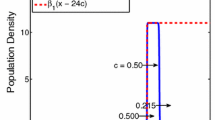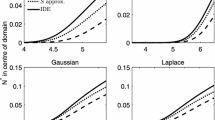Abstract
Many species exhibit dispersal processes with positive density- dependence. We model this behavior using an integrodifference equation where the individual dispersal probability is a monotone increasing function of local density. We investigate how this dispersal probability affects the spreading speed of a single population and its ability to persist in fragmented habitats. We demonstrate that density-dependent dispersal probability can act as a mechanism for coexistence of otherwise non-coexisting competitors. We show that in time-varying habitats, an intermediate dispersal probability will evolve. Analytically, we find that the spreading speed for the integrodifference equation with density-dependent dispersal probability is not linearly determined. Furthermore, the next-generation operator is not compact and, in general, neither order-preserving nor monotonicity-preserving. We give two explicit examples of non-monotone, discontinuous traveling-wave profiles.
Similar content being viewed by others
References
Aronson, D.G., Weinberger, H.F.: Nonlinear diffusion in population genetics, combustion and nerve pulse propagation. In: Goldstein, J.A. (ed.) Partial Differential Equations and related Topics. Lect. Notes in Math. 446, Springer, New York (1975)
Berestycki H., Hamel F. and Roques L. (2005). Analysis of the periodically fragmented environment model. I. species persistence. J. Math. Biol. 51: 75–113
Bonafede S., Cirmi G.R. and Tedeev A.F. (1998). Finite speed of propagation for the porous media equation. SIAM J. Math. Anal. 29(6): 1381–1398
Botsford L.W., Hastings A. and Gaines S.D. (2001). Dependence of sustainability on the configuration of marine reserves and larval dispersal distance. Ecol. Lett. 4: 144–150
Cantrell R.S. and Cosner C. (1993). Should a park be an island?. SIAM Appl. Math. 53: 219–252
Cantrell, R.S., Cosner, C.: Spatial ecology via reaction-diffusion equations. In: Mathematical and Computational Biology. Wiley, New York (2003)
Clark J.S., Fastie D., Hurtt G., Jackson S.T., Johnson C., King G.A., Lewis M.A., Lynch J., Pacala S., Prentice C., Schupp E., Webb III T. and Wyckoff P. (1998). Reid’s paradox of rapid plant migration. Bioscience 48: 13–24
Cobbold C., Lewis M.A., Lutscher F. and Roland J. (2005). How parasitism affects critical patch size in a host-parasitoid system: application to Forest Tent Caterpillar. Theor. Popul. Biol. 67(2): 820–828
Cruywagen G.C., Kareiva P., Lewis M.A. and Murray J.D. (1996). Competition in a spatially heterogeneous environment: Modelling the risk of spread of a genetically engineered population. Theor. Popul. Biol. 49(1): 1–38
Denno R.F. and Roderick G.K. (1992). Density-related dispersal in grasshoppers—effects of interspecific crowding. Ecology 73: 1323–1334
Dieckmann U. (1997). Can adaptive dynamics invade?. Trends Ecol. Evol. 12: 128–131
Dieckmann U., O’Hara B. and Weisser W. (1999). The evolutionary ecology of dispersal. Trends Ecol. Evol. 14: 88–90
Dockery J., Hutson V., Mischaikow K. and Pernarowski M. (1998). The evolution of slow dispersal rates: a reaction-diffusion model. J. Math. Biol. 37: 61–83
Fagan W.F. and Lutscher F. (2006). The average dispersal success approximation: a bridge linking home range size, natal dispersal and metapopulation dynamics to critical patch size and reserve design. Ecol. Appl. 16(2): 820–828
Fisher R.A. (1937). The advance of advantageous genes. Ann. Eugenics 7: 355–369
Gurney W.S.C. and Nisbet R.M. (1975). The regulation of inhomogeneous populations. J. Theor. Biol. 52: 441–457
Hadeler K.P. (1994). Travelling fronts for correlated random walks. Can. Appl. Math. Quart. 2: 27–43
Hadeler K.P. and Lewis M.A. (2002). Spatial dynamics of the diffusive logistic equation with sedentary component. Can. Appl. Math. Quart. 10: 473–500
Hamilton W.D. and May R.M. (1977). Dispersal in stable habitats. Nature 269: 578–581
Harada T., Tabuchi R. and Koura J. (1997). Mogratory syndrome in the water strider aquarius paludum (heteroptera: Gerridae) reared in high versus low nymphal densities. Eur. J. Entomol. 94: 445–452
Hardin D.P., Takáč P. and Webb G.F. (1990). Dispersion population models discrete in time and continuous in space. J. Math. Biol. 28: 1–20
Hastings A., Cuddington K., Davies K.F., Dugaw C.J., Elmendorf A., Freestone A., Harrison S., Holland M., Lambrinos J., Malvadkar U., Melbourne B.A., Moore K., Taylor C. and Thomson D. (2005). The spatial spread of invasions: new developments in theory and evidence. Ecol. Lett. 8: 91–101
Hillen T. (2003). Transport equations with resting phase. Eur. J. Appl. Math. 14: 613–636
Hosono Y. (1998). The minimal speed of traveling fronts for a diffusive lotka volterra competition model. Bull. Math. Biol. 60: 435–458
Hutson V., Martinez S., Mischaikow K. and Vickers G.T. (2003). The evolution of dispersal. J. Math. Biol. 46: 483–517
Hutson V., Mischaikow K. and Poláćik P. (2001). The evolution of dispersal rates in a heterogeneous time-periodic environment. J. Math. Biol. 43: 501–533
Johnson M.L. and Gaines M.S. (1990). Evolution of dispersal: theoretical models and empirical tests using birds and mammals. Annu. Rev. Ecol. Syst. 21: 449–480
Kawasaki K. and Shigesada N. (2007). An integrodifference model for biological invasions in a periodically fragmented environment. Jpn. J. Ind. Appl. Math. 24: 3–15
Kinezaki N., Kawasaki K., Takasu F. and Shigesada N. (2003). Modeling biological invasions into periodically fragmented environments. Theor. Popul. Biol. 64: 291–302
Kolmogorov A.N., Petrovskii I.G. and Piskunov N.S. (1937). A study of the equation of diffusion with increase in the quantity of matter, and its application to a biological problem. Bjol. Moskovskovo Gos. Univ. 17: 1–72
Kot M. (1992). Discrete-time travelling waves: ecological examples. J. Math. Biol. 30: 413–436
Kot M., Lewis M.A. and Driessche P. (1996). Dispersal data and the spread of invading organisms. Ecology 77: 2027–2024
Kot M. and Schaffer W.M. (1986). Discrete-time growth-dispersal models. Math. Biosci. 80: 109–136
Lewis M.A., Li B. and Weinberger H.F. (2002). Spreading speed and linear determinacy for two-species competition models. J. Math. Biol. 45: 219–233
Lui R. (1983). Existence and stability of traveling wave solutions of a nonlinear integral operator. J. Math. Biol. 16: 199–220
Lui R. (1989). Biological growth and spread modeled by systems of recursions. I Mathematical theory. Math. Biosci. 93: 269–295
Lui R. (1989). Biological growth and spread modeled by systems of recursions. II Biological theory. Math. Biosci. 93: 297–312
Lutscher F. (2007). A short note on short dispersal distances. Bull. Math. Biol. 69(5): 1615–1630
Lutscher F. and Lewis M.A. (2004). Spatially-explicit matrix models. A mathematical analysis of stage-structured integrodifference equations. J. Math. Biol. 48: 293–324
Lutscher F., Lewis M.A. and McCauley E. (2006). The effects of heterogeneity on population persistence and invasion in rivers. Bull. Math. Biol. 68(8): 2129–2160
Lutscher F., Pachepsky E. and Lewis M.A. (2005). The effect of dispersal patterns on stream populations. SIAM Appl. Math. 65(4): 1305–1327
Matthysen E. (2005). Density-dependent dispersal in birds and mammals. Ecography 28: 403–416
Medlock J. and Kot M. (2003). Spreading diseases: integro-differential equations new and old. Math. Biosci. 184: 201–222
Murray J.D. (2001). Mathematical Biology I: An Introduction. Springer-Verlag, Berlin
Neubert M.G. and Caswell H. (2000). Demography and dispersal: calculation and sensitivity analysis of invasion speeds for structured populations. Ecology 81(6): 1613–1628
Neubert M.G., Kot M. and Lewis M.A. (1995). Dispersal and pattern formation in a discrete-time predator-prey model. Theor. Popul. Biol. 48(1): 7–43
Okubo A. and Levine S.A. (2001). Diffusion and ecological problems: modern perspectives. Springer, New York
Pachepsky E., Lutscher F., Nisbet R. and Lewis M.A. (2005). Persistence, spread and the drift paradox. Theor. Popul. Biol. 67: 61–73
Sherratt J. and Marchant B.P. (1996). Nonsharp traveling wave fronts in the fisher equation with nonlinear degenerate diffusion. Appl. Math. Lett. 9: 33–38
Shigesada N., Kawasaki K. and Teramoto E. (1986). Traveling periodic waves in heterogeneous environments. Theor. Popul. Biol. 30: 143–160
Skellam J.G. (1951). Random dispersal in theoretical populations. Biometrika 38: 196–218
Travis J.M.J., Murrell D.J. and Dytham C. (1999). The evolution of density-dependent dispersal. Proc. R. Soc. Lond. B 266: 1837–1842
Metz J.A.J., Diekmann O. and van den Bosch F. (1990). The velocity of spatial population expansion. J. Math. Biol. 28: 529–565
Van Kirk R.W. and Lewis M.A. (1997). Integrodifference models for persistence in fragmented habitats. Bull. Math. Biol. 59(1): 107–137
Veit R.R. and Lewis M.A. (1996). Dispersal, population growth and the Allee effect: dynamics of the house finch invasion in eastern North America. Am. Nat. 148(2): 255–274
Volkov, D., Lui, R.: Spreading speed and traveling wave solutions of a partially sedentary population. IMA J. Appl. Math. (in press)
Wang M.-H., Kot M. and Neubert M.G. (2002). Integrodifference equations, Allee effects, and invasions. J. Math. Biol. 44: 150–168
Weinberger H.F. (1982). Long-time behavior of a class of biological models. SIAM J. Math. Anal. 13: 353–396
Weinberger H.F. (2002). On spreading speeds and traveling waves for growth and migration models in a periodic habitat. J. Math. Biol. 45: 511–548
Author information
Authors and Affiliations
Corresponding author
Rights and permissions
About this article
Cite this article
Lutscher, F. Density-dependent dispersal in integrodifference equations. J. Math. Biol. 56, 499–524 (2008). https://doi.org/10.1007/s00285-007-0127-1
Received:
Revised:
Published:
Issue Date:
DOI: https://doi.org/10.1007/s00285-007-0127-1
Keywords
- Integrodifference equations
- Spreading speeds
- Density-dependent dispersal
- Habitat fragmentation
- Competition
- Evolution of dispersal




